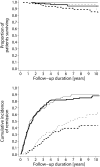Long-term outcomes in idiopathic membranous nephropathy using a restrictive treatment strategy
- PMID: 24029426
- PMCID: PMC3871776
- DOI: 10.1681/ASN.2013020185
Long-term outcomes in idiopathic membranous nephropathy using a restrictive treatment strategy
Abstract
Recently published Kidney Disease Improving Global Outcomes (KDIGO) guidelines recommend limiting the use of immunosuppressive drugs in idiopathic membranous nephropathy to patients at the highest risk of kidney failure. However, recommendations are based on natural history rather than direct assessment of a restrictive treatment strategy. Here, we describe the long-term outcomes of treating a large cohort of patients with idiopathic membranous nephropathy according to a restrictive treatment policy. We analyzed data for 254 patients who visited our outpatient clinic between 1995 and 2009. All patients were treated with angiotensin-converting enzyme inhibitors or angiotensin-receptor blockers. Immunosuppressive therapy was recommended in cases of deteriorating renal function or untreatable nephrotic syndrome. Primary outcomes for the present study were renal replacement therapy and death. Secondary outcomes included adverse events during follow-up and remission of proteinuria. In total, 124 patients (49%) received immunosuppressive therapy, which predominantly consisted of cyclophosphamide combined with steroids. Ten-year cumulative incidence rates were 3% for renal replacement therapy and 10% for death. Partial remission rates were 39%, 70%, and 83% after 1, 3, and 5 years, respectively; complete remission rates were 5%, 24%, and 38% at 1, 3, and 5 years, respectively. A serious adverse event occurred in 23% of all patients. The most notable complications were infections (17%), leukopenia (18%), cardiovascular events (13%), and malignancies (8%). In conclusion, the use of a restrictive treatment strategy in this cohort of patients with idiopathic membranous nephropathy yielded favorable outcomes while limiting the number of patients exposed to toxic drugs. These results support current KDIGO guidelines.
Figures


References
-
- du Buf-Vereijken PW, Branten AJ, Wetzels JF: Idiopathic membranous nephropathy: Outline and rationale of a treatment strategy. Am J Kidney Dis 46: 1012–1029, 2005 - PubMed
-
- Ponticelli C, Zucchelli P, Passerini P, Cesana B, Locatelli F, Pasquali S, Sasdelli M, Redaelli B, Grassi C, Pozzi C, et al. : A 10-year follow-up of a randomized study with methylprednisolone and chlorambucil in membranous nephropathy. Kidney Int 48: 1600–1604, 1995 - PubMed
-
- Jha V, Ganguli A, Saha TK, Kohli HS, Sud K, Gupta KL, Joshi K, Sakhuja V: A randomized, controlled trial of steroids and cyclophosphamide in adults with nephrotic syndrome caused by idiopathic membranous nephropathy. J Am Soc Nephrol 18: 1899–1904, 2007 - PubMed
Publication types
MeSH terms
Substances
LinkOut - more resources
Full Text Sources
Other Literature Sources

